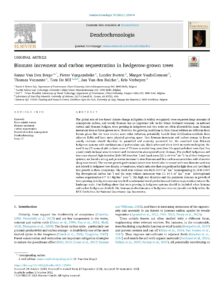Van Den Berge S., Vangansbeke P., Baeten L., Vanhellemont M., Vanneste T., De Mil T., Van den Bulcke J., Verheyen K. [2021] Biomass increment and carbon sequestration in hedgerow-grown trees. Dendrochronologia 70, 125894. doi : 10.1016/j.dendro.2021.125894
Abstract :
The global role of tree-based climate change mitigation is widely recognized; trees sequester large amounts of atmospheric carbon, and woody biomass has an important role in the future biobased economy. In national carbon and biomass budgets, trees growing in hedgerows and tree rows are often allocated the same biomass increment data as forest-grown trees. However, the growing conditions in these linear habitats are different from forests given that the trees receive more solar radiation, potentially benefit from fertilization residuals from adjacent fields and have more physical growing space. Tree biomass increment and carbon storage in linear woody elements should therefore be quantified and correctly accounted for. We examined four different hedgerow systems with combinations of pedunculate oak, black alder and silver birch in northern Belgium. We used X-ray CT scans of pith-to-bark cores of 73 trees to model long-term (tree life span) and short-term (last five years) trends in basal area increment and increment in aboveground stem biomass. The studied hedgerows and tree rows showed high densities (168–985 trees km-1) and basal areas (22.1–44.9 m2 km-1). In all four hedgerow systems, we found a strong and persistent increase in stem biomass and thus carbon accumulation with diameter (long-term trend). The current growth performance (short-term trend) also increased with tree diameter and was not related to hedgerow tree density or basal area, which indicates that competition for light does not (yet) limit tree growth in these ecosystems. The total stem volume was 82.0–339.7 m3 km-1 (corresponding to 18.8–100.7 Mg aboveground carbon km-1) and the stem volume increment was 3.1–14.5 m3 km-1 year-1 (aboveground carbon sequestration 0.7–4.3 Mg km-1 year-1). The high tree densities and the persistent increase in growth of trees growing in hedgerow systems resulted in substantial wood production and carbon sequestration rates at the landscape scale. Our findings show that trees growing in hedgerow systems should be included when biomass and carbon budgets are drafted. The biomass production rates of hedgerow trees we provide can help refine the IPCC Guidelines for National Greenhouse Gas Inventories.
Consultez la notice complète de l’article sur ORBi

